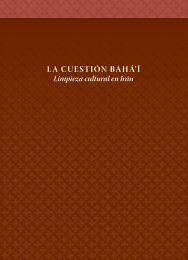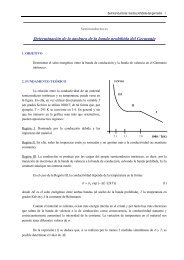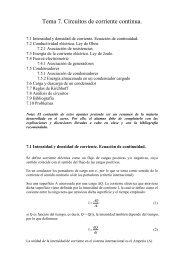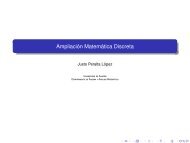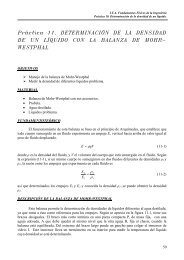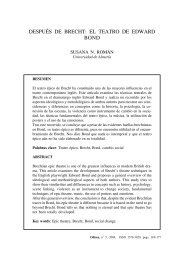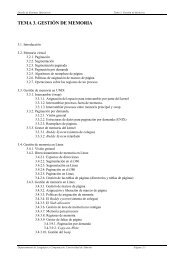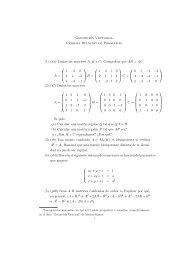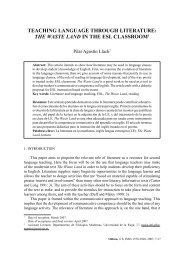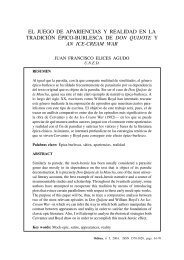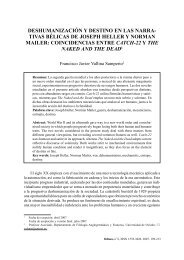textual representations of chicana identity in sandra cisneros's ...
textual representations of chicana identity in sandra cisneros's ...
textual representations of chicana identity in sandra cisneros's ...
Create successful ePaper yourself
Turn your PDF publications into a flip-book with our unique Google optimized e-Paper software.
María Alonso Alonso<br />
Textual Representations <strong>of</strong> Chicana Identity...<br />
TEXTUAL REPRESENTATIONS OF CHICANA<br />
IDENTITY IN SANDRA CISNEROS’S CARAMELO OR<br />
PURO CUENTO 1<br />
María Alonso Alonso, Universidade de Vigo<br />
Email: mariaalonsoalonso@uvigo.es<br />
Resumen: El pr<strong>in</strong>cipal objetivo de este estudio es el de analizar la representación <strong>textual</strong><br />
de los dist<strong>in</strong>tos rasgos dist<strong>in</strong>tivos presentes en la producción literaria Chicana en Caramelo<br />
or Puro Cuento de Sandra Cisneros, publicada en 2002. Para este propósito se tendrán en<br />
consideración cuestiones relativas a la subjetividad cultural, la naturaleza femen<strong>in</strong>a, la<br />
historia, el racismo y el machismo, así como aspectos l<strong>in</strong>güísticos con el n de explorar<br />
algunos elementos signi cantes en esta obra de Cisneros que podría ser considerada<br />
como un ejemplo de conciencia femen<strong>in</strong>a en la literatura Chicana.<br />
Palabras clave: literatura <strong>chicana</strong>, identidad cultural, nueva mestiza, folklore<br />
mexicano.<br />
Título en español: Representaciones <strong>textual</strong>es de identidad <strong>chicana</strong> en Caramelo o Puro<br />
Cuento de Sandra Cisneros.<br />
Abstract: The ma<strong>in</strong> purpose <strong>of</strong> this study is to analyse the <strong>textual</strong> representation <strong>of</strong><br />
the various dist<strong>in</strong>ctive features present with<strong>in</strong> Chicana literary production <strong>in</strong> Sandra<br />
Cisneros’s Caramelo or Puro Cuento, published <strong>in</strong> 2002. In order to accomplish this,<br />
issues such as cultural subjectivity, female nature, history, racism and machismo, as well<br />
as l<strong>in</strong>guistic aspects will be taken <strong>in</strong>to consideration <strong>in</strong> order to explore some signi cant<br />
elements with<strong>in</strong> Cisneros’s work, which could be considered as be<strong>in</strong>g an example <strong>of</strong> a<br />
new female consciousness <strong>in</strong> Chicana literature.<br />
Keywords: Chicana literature, cultural <strong>identity</strong>, new mestiza, Mexican folklore.<br />
INTRODUCTION<br />
Sandra Cisneros’s Caramelo or Puro Cuento, published <strong>in</strong> 2002, could be considered<br />
as be<strong>in</strong>g the <strong>in</strong>heritor <strong>of</strong> a differentiat<strong>in</strong>g female voice with<strong>in</strong> turn-<strong>of</strong>-the-century Chicana<br />
literature. Through the use <strong>of</strong> speci c style, themes and motifs, this novel gives form to a<br />
conscious subjectivity <strong>of</strong> women <strong>of</strong> Mexican orig<strong>in</strong> liv<strong>in</strong>g <strong>in</strong> a North American context.<br />
Depart<strong>in</strong>g from the conceptual blend<strong>in</strong>g <strong>of</strong> what Madsen calls “double stigma” (2000:<br />
4) and Pesquera and Segura refer to as the “triple oppression” (1996: 233), this study<br />
will focus on analys<strong>in</strong>g the most characteristic trends <strong>of</strong> what could be referred to as<br />
Chicana experiences and which will be evident <strong>in</strong> four ma<strong>in</strong> areas: gender, race, class and<br />
1 Date <strong>of</strong> reception: 7 April 2011<br />
Date <strong>of</strong> acceptance: 17 November 2011<br />
15<br />
Odisea, n º 12, ISSN 1578-3820, 2011, 15-27
16 María Alonso Alonso<br />
Odisea, n º 12, ISSN 1578-3820, 2011, 15-27<br />
Textual Representations <strong>of</strong> Chicana Identity...<br />
culture. Accord<strong>in</strong>gly, “double consciousness or stigma” describes for Madsen the Chicana<br />
“experience <strong>of</strong> oppression both as a woman and as a member <strong>of</strong> an ethnic m<strong>in</strong>ority” (2000:<br />
4); whereas Pesquera and Segura talk about a “triple oppression” which is the result <strong>of</strong><br />
“racial/ethnic group, culture and class -as well as gender” (1996: 215) subord<strong>in</strong>ation <strong>of</strong><br />
Chicana women.<br />
Cisneros is one <strong>of</strong> the most representative gures <strong>of</strong> what is known as the Decade<br />
<strong>of</strong> the Chicana, the 1980s, which was the result <strong>of</strong> the Chicana writers’ determ<strong>in</strong>ation to<br />
challenge ego-driven one-man cult shows (Lomeli and Herrera-Sobek 2000: 291) <strong>of</strong> Chicano<br />
literary production up to that time. Their ma<strong>in</strong> goal was to give voice to those stories that<br />
had been avoided, neglected and even rejected, but which were signi cant because <strong>of</strong> their<br />
use <strong>of</strong> themes and motifs common to many Chicana postmodern works. Under the form <strong>of</strong><br />
a Künstlerroman-also understood to be a k<strong>in</strong>d <strong>of</strong> ctional autobiography that describes the<br />
awaken<strong>in</strong>g <strong>of</strong> the author as an artist <strong>in</strong> a sometimes hostile environment-, Cisneros uses<br />
fragmented imagery throughout all three parts <strong>of</strong> the novel. These appear under the form <strong>of</strong><br />
captured moments or scenes attached to a common memory which is shared by the narrator<br />
while her familiar background serves as a narrative frame for the historical context.<br />
In this article, there will be a tendency to connect literary criticism with speci c <strong>in</strong>cidents<br />
or characters <strong>in</strong> the novel, s<strong>in</strong>ce one <strong>of</strong> the ma<strong>in</strong> motivations <strong>of</strong> this study is, apart from<br />
<strong>of</strong>fer<strong>in</strong>g an analysis <strong>of</strong> Caramelo, to address directly some <strong>of</strong> the most signi cant works on<br />
Chicana/o criticism. But before enter<strong>in</strong>g <strong>in</strong>to a detailed analysis <strong>of</strong> the themes and motifs<br />
present <strong>in</strong> the novel, this paper will focus its attention on the similarities between Celaya,<br />
Caramelo’s narrator, and Cisneros herself. The Mexican Revolution acts as a historical<br />
background for the ancestral history <strong>of</strong> both women, as well as an account<strong>in</strong>g for the wealth<br />
<strong>of</strong> past generations. Both were also born <strong>in</strong> Chicago as daughters <strong>of</strong> Mexican immigrants<br />
and both are the only females <strong>in</strong> a family <strong>of</strong> seven male children. Furthermore, regular<br />
trips between Chicago and Mexico City became a constant feature <strong>of</strong> their childhood; and,<br />
nally, both women had an early awareness <strong>of</strong> their will to become artists. As it will be here<br />
suggested, there are similarities enough to conclude that Caramelo is an autobiography <strong>of</strong><br />
the author, with added ctionalisations.<br />
In the follow<strong>in</strong>g po<strong>in</strong>ts, Madsen’s (2000: 6) theme classi cation list, which she considers<br />
as be<strong>in</strong>g characteristic <strong>of</strong> most Chicana literary production, will be taken <strong>in</strong>to consideration<br />
to show to what extent Caramelo succeeds <strong>in</strong> represent<strong>in</strong>g various dist<strong>in</strong>ctive features <strong>of</strong><br />
Chicana writ<strong>in</strong>g.<br />
HYBRID CULTURAL IDENTITY / FRAGMENTARY SUBJECTIVITY<br />
Among other conceptual and idealised de nitions <strong>of</strong> culture, Clyde Kluckhohn provides<br />
one <strong>of</strong> the most <strong>in</strong>terest<strong>in</strong>g formalisation <strong>of</strong> it as “all those historically created designs for<br />
liv<strong>in</strong>g [...] which exist at any given time as potential guides for the behaviour <strong>of</strong> [humank<strong>in</strong>d]”<br />
(<strong>in</strong> Maciel and Herrera-Sobek 1998: 7). Indeed, Chicana <strong>identity</strong> is dom<strong>in</strong>ated by a series<br />
<strong>of</strong> bluepr<strong>in</strong>ts that have been commonly accepted as cultural peculiarities <strong>of</strong> an <strong>in</strong>herited<br />
folklore. Mexican folklore, or as it is better known cultura popular, is considered as be<strong>in</strong>g a<br />
hybrid concept that <strong>in</strong>cludes myths, customs, beliefs, different forms <strong>of</strong> artistic expression,<br />
religion and social or political organisation <strong>of</strong> everyday life. Moreover, Chicana writ<strong>in</strong>g
María Alonso Alonso<br />
Textual Representations <strong>of</strong> Chicana Identity...<br />
seems to stress the phenomenon <strong>of</strong> a transnational sociocultural system, which could be<br />
described as be<strong>in</strong>g the reconstruction <strong>of</strong> a given cultura popular <strong>in</strong> a foreign territory.<br />
Consequently, the peoples that ma<strong>in</strong>ta<strong>in</strong> their cultural <strong>identity</strong> <strong>in</strong> an unfamiliar country might<br />
challenge “conventional notions <strong>of</strong> immigrant assimilation and [mark] new possibilities<br />
<strong>in</strong> the struggles for social, cultural and political empowerment <strong>of</strong> [...] marg<strong>in</strong>al groups”<br />
(Acosta-Belén and Santiago 1998: 34).<br />
Caramelo seems to imply a rede nition <strong>of</strong> Chicana <strong>identity</strong> <strong>in</strong> the United States where<br />
the <strong>in</strong>dividuals need to constantly adjust themselves to their new cultural status. Family,<br />
<strong>in</strong> many cases, works as the carrier <strong>of</strong> values, which <strong>in</strong>dicates subord<strong>in</strong>ation regard<strong>in</strong>g the<br />
ethics and beliefs <strong>of</strong> the head <strong>of</strong> the family. Accord<strong>in</strong>g to this, Chicana family submission<br />
will depend on gender-based norms because, as Del Castillo po<strong>in</strong>ts out, the family <strong>in</strong> Mexico<br />
is “hierarchical <strong>in</strong> structure, asymmetrical <strong>in</strong> social and gender relations, genealogical <strong>in</strong><br />
patterns <strong>of</strong> residence, and loyal to the family <strong>in</strong> its moral economy” (1996: 212). Therefore,<br />
men appear to have authority over women as do the older over the younger.<br />
In Caramelo, the concept <strong>of</strong> family is important-but still dissimilar to the previously<br />
mentioned idea due to the grandmother’s frequent comments about how different and<br />
<strong>in</strong>ferior their customs are-to the po<strong>in</strong>t that Cisneros opens her novel with a portrait <strong>of</strong> every<br />
member <strong>of</strong> the Reyes’s house on a trip to Acapulco. This approach helps the narrator to<br />
characterise the different members <strong>of</strong> the clan. Celaya, the narrator, presents her family<br />
history as a puzzle that the reader has to construct <strong>in</strong> order to understand the nal irony<br />
beh<strong>in</strong>d the story. Two different levels <strong>of</strong> reality seem to coexist dur<strong>in</strong>g most parts <strong>of</strong> the<br />
narration. On the one hand, the characters build up their own past accord<strong>in</strong>g to their own<br />
parameters and desires and, on the other hand, the truth beh<strong>in</strong>d those manipulated stories<br />
hides a series <strong>of</strong> complexities that determ<strong>in</strong>es the fate <strong>of</strong> future generations.<br />
Furthermore, the concept <strong>of</strong> the family is understood <strong>in</strong> its Mexican-American sense<br />
s<strong>in</strong>ce life <strong>in</strong> Chicago challenges any other notion. The idea <strong>of</strong> ma<strong>in</strong>ta<strong>in</strong><strong>in</strong>g the family honour<br />
as be<strong>in</strong>g untouchable is a constant throughout the novel, even when Celaya suggests liv<strong>in</strong>g<br />
alone <strong>in</strong> the future, her father immediately recrim<strong>in</strong>ates her by say<strong>in</strong>g “good girls don’t<br />
leave their father’s house until they marry and not before” (Caramelo: 359). What is even<br />
more illustrative <strong>of</strong> family honour is that Celaya’s father puts the onus on his daughter to<br />
hide his own true history so that she cannot repeat models <strong>of</strong> behaviour that have been a<br />
consistent part <strong>of</strong> the Reyes’s family and that are considered extremely negative. Inocencio<br />
tries to challenge her daughter’s dest<strong>in</strong>o warn<strong>in</strong>g her that “if [she] leave[s her] father’s<br />
house without a husband [she is] worse than a dog. [She isn’t his] daughter. [She isn’t] a<br />
Reyes” (360). Honour is, <strong>in</strong>deed, an important issue for the senior members <strong>of</strong> the family<br />
and that is why they <strong>in</strong>sist on the fact that they “are Reyes and must behave like Reyes”<br />
(159) which is quite an ironic statement when the reader starts discover<strong>in</strong>g all the secrets<br />
which are hidden throughout the lives <strong>of</strong> the family members.<br />
Territory is probably another cause <strong>of</strong> anxiety and ambivalent <strong>identity</strong>. Cisneros referred<br />
to her position as be<strong>in</strong>g that <strong>of</strong> a daughter <strong>of</strong> a Mexican liv<strong>in</strong>g <strong>in</strong> Chicago which she l<strong>in</strong>ked<br />
to a k<strong>in</strong>d <strong>of</strong> schizophrenia propitiated by the fact that “be<strong>in</strong>g a Mexican woman liv<strong>in</strong>g <strong>in</strong><br />
an American society, but not belong<strong>in</strong>g to either culture” (Madsen 2000: 108). Cisneros’s<br />
history is the same as that <strong>of</strong> hundreds <strong>of</strong> thousands <strong>of</strong> Mexicans who have been travell<strong>in</strong>g<br />
to the United States s<strong>in</strong>ce Mexico’s Northern prov<strong>in</strong>ces were lost <strong>in</strong> the Mexican-American<br />
17<br />
Odisea, n º 12, ISSN 1578-3820, 2011, 15-27
18 María Alonso Alonso<br />
Odisea, n º 12, ISSN 1578-3820, 2011, 15-27<br />
Textual Representations <strong>of</strong> Chicana Identity...<br />
war <strong>of</strong> 1848. Actually, immigration became a recurr<strong>in</strong>g theme <strong>in</strong> literature because the<br />
change <strong>in</strong> physical location conditions <strong>identity</strong>. This is what Acosta-Belén and Santiago<br />
refer to as “el ir y venir <strong>of</strong> those from ‘here’ and ‘there”’ (1998: 36). Even though there are<br />
authors who reject the idea <strong>of</strong> the borderland due to its idealised connotations, Sánchez’s<br />
perception <strong>of</strong> it as “a social space <strong>of</strong> concrete social practices constructed to designate a<br />
political boundary” (1998: 106) will be taken <strong>in</strong>to consideration here as it highlights the fact<br />
that it is not only a physical construction but one that actually limits political powers.<br />
There are many examples <strong>of</strong> how the borderland works as a divisive physical and<br />
imag<strong>in</strong>ary l<strong>in</strong>e <strong>in</strong> the novel. Mexican scenery is compared and contrasted to that <strong>of</strong> Chicago<br />
by means <strong>of</strong> a rich description full <strong>of</strong> life that is perceived through the senses:<br />
Churches the color <strong>of</strong> an. Vendors sell<strong>in</strong>g slices <strong>of</strong> jícama with chile, lime juice,<br />
and salt [...] Little girls <strong>in</strong> Sunday dresses like lace bells, like umbrellas, like parachutes,<br />
the more lace and froufrou the better. Houses pa<strong>in</strong>ted purple, electric blue, tiger orange,<br />
aquamar<strong>in</strong>e, a yellow like a taxicab, hibiscus red with a yellow-and-green fence [...] A<br />
workman carry<strong>in</strong>g long metal pipe on his shoulder, whistl<strong>in</strong>g fffttt-fffttt to warn people.<br />
(Caramelo: 18)<br />
A description that is antithetical to the image given <strong>of</strong> Chicago as “a city cursed with<br />
not one but two bad words for a name: ‘the fucked one’ and ‘the one who shat”’ (137).<br />
Even so, although Mexico is considered as “the center <strong>of</strong> the universe” (25) by Celaya<br />
when she was a child, once she goes back as an adult, she realises that “Mexico City looks<br />
more like cities <strong>in</strong> the US, as if it suddenly got sick and tired” (258). Furthermore, when<br />
Celaya’s family moves to San Antonio, her physical dislocation is even more evident. They<br />
are, apart from be<strong>in</strong>g immigrants from a foreign nation, also migrants with<strong>in</strong> the US and<br />
the sense <strong>of</strong> place seems to vanish for some time caus<strong>in</strong>g a great deal <strong>of</strong> anxiety: “Home?<br />
Where’s that? North? South? Mexico? San Antonio? Chicago?” (380).<br />
The image <strong>of</strong> the borderland is emphasised by the use <strong>of</strong> ‘here’ and ‘there’ depend<strong>in</strong>g<br />
on which side the speaker is placed, whether physical or emotional. Accord<strong>in</strong>g to this, the<br />
“Mexicans <strong>of</strong> this side [are] compared to the Mexicans from that side” (235). Furthermore,<br />
while the Awful Grandmother refers to the US as ‘that side’, second and third generation<br />
immigrants consider the US as ‘this side’. Therefore ‘here’ and ‘there’ are constantly used<br />
to refer to both sides <strong>of</strong> the imag<strong>in</strong>ary and physical border l<strong>in</strong>e that separates Mexican<br />
cultural <strong>identity</strong>, for example: “I’ve never been there [Mexico][...] We’ve been here [US]<br />
seven generations” (328) or “Thanks God they were born on this side” (373).<br />
This idea <strong>of</strong> be<strong>in</strong>g <strong>in</strong>-between is so transcendental <strong>in</strong> Mexican imagery that even the<br />
Nahuatl language has a word, Nepantla, to describe the territory that people cross when<br />
mov<strong>in</strong>g from one place to another and which also implies a change <strong>in</strong> class, culture and<br />
<strong>identity</strong>. The mental nepantilism <strong>of</strong> the new mestiza, <strong>in</strong> Anzaldúa’s words, is the result <strong>of</strong> a<br />
cultural transfer from one group to another, which generates the ambivalent state <strong>of</strong> liv<strong>in</strong>g<br />
<strong>in</strong> the borderland as be<strong>in</strong>g “alienated from [the] mother culture [and] ‘alien’ <strong>in</strong> the dom<strong>in</strong>ant<br />
culture” (1987: 20). Moreover, as Segura and Pesquera highlight, “to be disoriented <strong>in</strong> space<br />
is the ‘normal’ way <strong>of</strong> be<strong>in</strong>g for [the] mestizas liv<strong>in</strong>g <strong>in</strong> the borderlands” (1998: 165). They<br />
compare this disorientation to the illusion <strong>of</strong> be<strong>in</strong>g <strong>in</strong> Nepantla, that is to say, “to experience
María Alonso Alonso<br />
Textual Representations <strong>of</strong> Chicana Identity...<br />
bouts <strong>of</strong> disassociation <strong>of</strong> <strong>identity</strong>, <strong>identity</strong> breakdowns and build ups” (165) generated by<br />
the concept <strong>of</strong> the borderland.<br />
As po<strong>in</strong>ted out, cultural <strong>identity</strong> <strong>in</strong> a Mexican context deeply conditions personal<br />
subjectivity, which is a concept that will serve to bridge the gap to the next aspect <strong>of</strong><br />
Madsen’s theme classi cation which is directly related to the way <strong>in</strong> which female sexuality<br />
is controlled from both public and private spheres.<br />
CONTROL OF FEMALE SEXUALITY<br />
Women’s sexuality is frequently rendered <strong>in</strong> the dual context <strong>of</strong> family/Church and<br />
usually “perceived as an obstacle, a burden, and a constra<strong>in</strong>t” (Madsen 2000: 33). Caramelo<br />
suggests that the female body <strong>in</strong> a Mexican patriarchal context rema<strong>in</strong>s useful as far as it<br />
serves the family or enterta<strong>in</strong>s men. Therefore, women become objects to bear and raise<br />
children or to satisfy male sexual appetite. It happens that once Mexican women have<br />
ful lled this purpose, they become <strong>in</strong>visible. These same patterns are still present <strong>in</strong> Chicana<br />
literature today. Actually, the Awful Grandmother could be considered as be<strong>in</strong>g an example<br />
<strong>of</strong> the previous statement through the next quotation:<br />
The Grandmother only became visible when her body changed and garnered the<br />
trophy <strong>of</strong> men’s attention. But then she had lost their attention as her body shifted and<br />
slouched <strong>in</strong>to disrepair [...] Men no longer looked at her, society no longer gave her much<br />
importance after her role <strong>of</strong> mother<strong>in</strong>g was over. (Caramelo: 347)<br />
But family and society are not the only burdens that women have to deal with. Religion,<br />
which is described <strong>in</strong> Caramelo as a “knife for castration” (156), is probably beh<strong>in</strong>d<br />
this repressive conduct. Chicanas utter between two dichotomous images <strong>of</strong> women’s<br />
sexuality. On the one hand, there is Guadalupe, the virg<strong>in</strong> mother that represents purity and<br />
unconditional love; on the other hand, there is Mal<strong>in</strong>che, the raped mother who is regarded as<br />
a traitor and whore. In her eye-open<strong>in</strong>g and thought-provok<strong>in</strong>g article about the implications<br />
<strong>of</strong> these two images <strong>in</strong> Mexican imagery, Alarcón (2004) considers that Guadalupe and<br />
Mal<strong>in</strong>che-or Mal<strong>in</strong>tz<strong>in</strong> as she spells the name-imply at a symbolic level a re<strong>in</strong>terpretation<br />
<strong>of</strong> the Christian dualism between positive and negative female representation. Thus, these<br />
two gures are <strong>of</strong> paramount importance when consider<strong>in</strong>g the mechanism <strong>of</strong> myth-creation<br />
and myth-re<strong>in</strong>terpretation, which has been recovered by scholars <strong>in</strong> recent decades from<br />
an academic perspective <strong>in</strong> order to <strong>in</strong>vestigate the close connection between the history<br />
<strong>of</strong> colonisation and the <strong>in</strong>herited image <strong>of</strong> Mal<strong>in</strong>che <strong>in</strong> Mexican folklore. Accord<strong>in</strong>gly,<br />
Chicana women have come to terms with different emotions generated by these two<br />
ambivalent gures. As Alarcón po<strong>in</strong>ts out, “among people <strong>of</strong> Mexican descent [...] anyone<br />
who has transgressed the boundaries <strong>of</strong> perceived group <strong>in</strong>terests and values <strong>of</strong>ten has been<br />
called a mal<strong>in</strong>che” (279). That is why female nature is seen as apprehensive and women<br />
are considered jealous by nature and “locas for love” (11). In fact, jealousy is regarded as<br />
a cultural feature <strong>of</strong> Mexican women: “We mexicanas, puro coraje y pasión. That’s what<br />
we’re made <strong>of</strong> [...] We love like we hate” (274) by the eldest but as someth<strong>in</strong>g negative for<br />
the young generations: “better to be lonely than jealous” (275).<br />
19<br />
Odisea, n º 12, ISSN 1578-3820, 2011, 15-27
20 María Alonso Alonso<br />
Odisea, n º 12, ISSN 1578-3820, 2011, 15-27<br />
Textual Representations <strong>of</strong> Chicana Identity...<br />
Celaya’s sexual awaken<strong>in</strong>g is carried out through what she heard from her classmates<br />
because it seems that <strong>in</strong> Chicana culture “the philosophy <strong>of</strong> sexual education for women<br />
was – the less said the better” (156). Moreover, sex is the favourite topic <strong>of</strong> teenage<br />
conversation because, <strong>in</strong> the US, it probably takes longer for a woman to mature and<br />
become ‘marriageable’. Celaya starts to question the repressive sexual education received<br />
at the Catholic school which she attends. Obviously, the <strong>representations</strong> <strong>of</strong> women that she<br />
receives from the nuns are confus<strong>in</strong>g <strong>in</strong> the twentieth century for a Chicana teenager due<br />
to the fact that there is no middle way: a woman is chaste like the Virgen de Guadalupe<br />
or is a prostitute like the Mal<strong>in</strong>che. Despite all the confusion, Celaya is clever enough to<br />
develop a critical attitude towards the repressive sexual education at school. She states: “I’m<br />
a virg<strong>in</strong>. I’m fourteen years old. I’ve never kissed a boy, and nobody kissed me. But one<br />
th<strong>in</strong>g I know for sure – Sister Odilia doesn’t know shit” (325). However, after she escapes<br />
from home with Ernesto, she is stigmatised as a ‘bad woman’ who brought shame to the<br />
family even from her own perspective: “I’m as evil as Eve” (388).<br />
As Madsen states, “the legacy <strong>of</strong> La Mal<strong>in</strong>che is the fragmentary subjectivity commonly<br />
experienced by Chicanas: women who seek approval on both Anglo and Mexican terms”<br />
(2000: 113). It might be impossible for a woman to nd an <strong>in</strong>-between position <strong>in</strong> a<br />
chauv<strong>in</strong>istic patriarchal society and so it is that sexuality passes from be<strong>in</strong>g a physical<br />
experience to become a moral restra<strong>in</strong><strong>in</strong>g force. The control <strong>of</strong> female sexuality is deeply<br />
connected to the importance <strong>of</strong> culture and <strong>identity</strong> <strong>in</strong> Chicana imagery, someth<strong>in</strong>g that will<br />
also be re ected upon <strong>in</strong> the next po<strong>in</strong>t <strong>of</strong> this paper which will focus on the importance <strong>of</strong><br />
past and stereotypes to condition female subjectivity.<br />
MEMORY AND ROLE MODELS<br />
Collective memory and history play a signi cant role <strong>in</strong> people’s <strong>identity</strong>. Memory, as<br />
history, is subjected to constant manipulation because, as Klor de Alva stresses, “people do<br />
not live their lives as abstract categories” (1998: 66). Lat<strong>in</strong> American historical memory is<br />
conditioned by what José Martí called Nuestra América, that is to say, the mixture between<br />
imposed European or Anglo-American models and non-Western elements which are peculiar<br />
to the peoples <strong>of</strong> the Americas. These elements validate the multiplicity <strong>of</strong> cultures and class<br />
autochthonous to the region and those result<strong>in</strong>g from a creolisation process (Acosta-Belén<br />
and Santiago 1998: 30).<br />
Still, European ancestry is viewed by some as a positive value to the detriment <strong>of</strong> the<br />
<strong>in</strong>digenous heritage. For <strong>in</strong>stance, it seems that Little Grandfather’s best achievement <strong>in</strong><br />
life was his Spanish l<strong>in</strong>eage from which rem<strong>in</strong>iscences are constantly related by the Reyes<br />
family to the others. Ironically, this l<strong>in</strong>eage is questioned when it is discovered that Eleuterio,<br />
Little Grandfather’s father, abandoned Seville and his wife after committ<strong>in</strong>g murder and,<br />
once <strong>in</strong> Mexico, “[l]ike all immigrants, Eleuterio Reyes did what he had to do, work<strong>in</strong>g the<br />
worst shifts <strong>in</strong> the roughest parts <strong>of</strong> towns at public bars and private parties where someone<br />
was sure to die” (Caramelo: 162). Indeed, most <strong>of</strong> the members <strong>of</strong> the family seem to be<br />
hid<strong>in</strong>g someth<strong>in</strong>g at some po<strong>in</strong>t <strong>in</strong> the novel, above all the female members who see their<br />
life threatened when other women appear <strong>in</strong> their sons’ lives. The concept <strong>of</strong> fate or dest<strong>in</strong>o<br />
enters the scene at this po<strong>in</strong>t because, if there is one th<strong>in</strong>g clear <strong>in</strong> Caramelo, it is that the
María Alonso Alonso<br />
Textual Representations <strong>of</strong> Chicana Identity...<br />
more one tries to hide the truth <strong>in</strong> one’s life, the more the same patterns will be repeated<br />
<strong>in</strong> future generations.<br />
As a matter <strong>of</strong> fact, memory is constantly manipulated throughout the novel. Most<br />
<strong>of</strong> the characters try to forget their mestizo or humble past which is a cause <strong>of</strong> shame<br />
for them. The direct consequence <strong>of</strong> these hidden complexes is the repetition <strong>of</strong> patterns<br />
from one generation to the next. The second section <strong>of</strong> Caramelo is very signi cant <strong>in</strong><br />
this sense. Celaya tells the story <strong>of</strong> the Awful Grandmother’s life with the assistance <strong>of</strong><br />
her grandmother’s ghost or spirit. The narrator constantly manipulates what the Awful<br />
Grandmother considers as her truth because she needs “the w<strong>in</strong>d for this part <strong>of</strong> the story”<br />
(175) due to the fact that, as we nd at the end <strong>of</strong> the novel, Awful Grandmother’s story is<br />
Celaya’s story. As it is stated at one po<strong>in</strong>t, history and memory “depends on whose truth<br />
you’re talk<strong>in</strong>g about [...] The same story becomes a different story depend<strong>in</strong>g on who is<br />
tell<strong>in</strong>g it” (156).<br />
There is no need to highlight the importance <strong>of</strong> the Awful Grandmother <strong>in</strong> the novel.<br />
She is, apart from the matriarch, the carrier <strong>of</strong> a collective and particular consciousness. She<br />
might be the agent <strong>of</strong> what Fromm and Macoby (<strong>in</strong> Del Castillo 1996: 214) call ‘sadistic<br />
machismo’ produced by ‘mother-centeredness’. Accord<strong>in</strong>g to these concepts, mothers play<br />
a decisive role <strong>in</strong> their sons’ perception <strong>of</strong> women:<br />
The mother is ... far more <strong>in</strong> uential than the father <strong>in</strong> giv<strong>in</strong>g the son his image <strong>of</strong><br />
the opposite sex ... All women are whores, Jezabels, and betrayers; the mother alone<br />
will not betray ... The man is therefore strongly attached to his mother emotionally and<br />
strangely bound by her authority. He is certa<strong>in</strong> to distrust women, whom he th<strong>in</strong>ks will<br />
betray him or disgrace his manl<strong>in</strong>ess by mak<strong>in</strong>g him a cuckold (pendejo) (Romanucci-<br />
Ross 1973: 58).<br />
One example <strong>of</strong> the idea <strong>in</strong>cluded <strong>in</strong> the quote above is the Awful Grandmother’s<br />
comment to her son: “wives are many, but mother only one” (Caramelo: 85). As a matter<br />
<strong>of</strong> fact and as Celaya admits, the Awful Grandmother became awful when she became a<br />
mother. It was then when the Awful Grandmother constitutes what Del Castillo (1996:<br />
214) refers to as the ‘uter<strong>in</strong>e family’ by strengthen<strong>in</strong>g the mother-son ties right up to the<br />
po<strong>in</strong>t when the daughter-<strong>in</strong>-law is perceived as an enemy who will try to destroy this<br />
bond between mother and son. Mothers are regarded by their sons <strong>in</strong> many cases as the<br />
<strong>in</strong>carnation <strong>of</strong> all the values represented by the Virgen de Guadalupe, the Virg<strong>in</strong> Mother<br />
who never abandons her children. A good example <strong>of</strong> this is Ernesto’s relationship with<br />
his mother. He even states at one po<strong>in</strong>t <strong>in</strong> the novel that “[his] mother is like la Virgen<br />
de Guadalupe” (Caramelo: 387). This way, “women support male dom<strong>in</strong>ance <strong>of</strong> other<br />
women as long as an elite group <strong>of</strong> elder women (mothers) have control over men (sons)”<br />
(Del Castillo 1996: 215). Maternal chauv<strong>in</strong>ism, therefore, becomes a recurrent issue <strong>in</strong><br />
Chicana literature, which is a concept that will also serve the purpose <strong>of</strong> relat<strong>in</strong>g the<br />
previously mentioned ideas to the next section which will be devoted to analys<strong>in</strong>g issues<br />
<strong>of</strong> gender, race and class <strong>in</strong> the novel.<br />
21<br />
Odisea, n º 12, ISSN 1578-3820, 2011, 15-27
22 María Alonso Alonso<br />
Odisea, n º 12, ISSN 1578-3820, 2011, 15-27<br />
Textual Representations <strong>of</strong> Chicana Identity...<br />
CONNECTION BETWEEN GENDER OPPRESSION AND RACIAL/CLASS OPPRES-<br />
SION<br />
Racism and machismo have a lot to do with the stereotypical image <strong>of</strong> Mexicans<br />
both with<strong>in</strong> and without their cultural bounds. Albert Memmi’s de nition <strong>of</strong> racism as a<br />
“generalized and nal assign<strong>in</strong>g <strong>of</strong> values to real or imag<strong>in</strong>ary differences, to the accuser’s<br />
bene t and at [the] victim’s expense, <strong>in</strong> order to justify the former’s own privilege or<br />
aggression” (Maciel and Rancho 2000: 94) is a good start<strong>in</strong>g po<strong>in</strong>t from where to analyse<br />
the oppressive connections between gender, race and class. These three elements, together<br />
with culture, are the cultural stigmas <strong>of</strong> Chicana consciousness. Furthermore, Gilroy’s<br />
idea quoted by Darder and Torres (1998: 8) <strong>of</strong> race be<strong>in</strong>g a social construct, rather than a<br />
biological or epistemological one, would be perfectly applicable <strong>in</strong> this particular case.<br />
Gender oppression is connected to racial oppression s<strong>in</strong>ce the Chicano Movement<br />
favoured male realisation to the detriment <strong>of</strong> female recognition. Chicano activists<br />
emphasise the urgency <strong>of</strong> liberat<strong>in</strong>g Mexican-orig<strong>in</strong> workers <strong>in</strong> the United States from the<br />
exploitative and subord<strong>in</strong>ate status from which they suffer. For this reason, the political<br />
party La Raza Unida was founded <strong>in</strong> order to accomplish political goals. In the latter years<br />
<strong>of</strong> the twentieth century, Chicana fem<strong>in</strong>ism-silenced until then-started to rise their voice<br />
with<strong>in</strong> El Movimiento to <strong>in</strong>corporate political claims which challenged “power relations<br />
<strong>in</strong> terms <strong>of</strong> patriarchy, sexuality, labor markets, and the family <strong>in</strong>stitution” (García 1996:<br />
99). Most <strong>of</strong> these women were at rst regarded as traitors to Mexican culture and values<br />
because El Movimiento only considered racial concerns and not gender ones.<br />
The fact that women were still relegated to the home sphere did noth<strong>in</strong>g to help improve<br />
the class status <strong>of</strong> Mexican families <strong>in</strong> the US. Women were not supposed to work outside<br />
the house even though the North American capitalist society demanded an active role<br />
from women outside this familial scope. Women’s economic <strong>in</strong>dependence was regarded<br />
as a threat to the male dom<strong>in</strong>ation <strong>of</strong> the family structure. Inocencio, Celaya’s father, is <strong>of</strong><br />
this op<strong>in</strong>ion: “What! A wife <strong>of</strong> m<strong>in</strong>e work? Don’t <strong>of</strong>fend me!” (Caramelo: 289). Hence,<br />
domestic violence appears as a consequence <strong>of</strong> men’s <strong>in</strong>security and their fear <strong>of</strong> los<strong>in</strong>g<br />
their position with<strong>in</strong> the family context. This happens <strong>in</strong> the novel when the authority <strong>of</strong><br />
Celaya’s father is questioned by his wife. It is then when he “clamps on to [her] arm and<br />
tries to force her to her feet, just to show he’s still the boss” (84).<br />
As suggested by Madsen (2000: 3), the term machismo was co<strong>in</strong>ed by Chicanos<br />
whereas the idea <strong>of</strong> womanhood is de ned by Chicana writers <strong>in</strong> opposition to the dom<strong>in</strong>ant<br />
mascul<strong>in</strong>e and patriarchal <strong>identity</strong> <strong>of</strong> the former. For Anzaldúa (1987: 83), there has been<br />
an evolution <strong>in</strong> the mean<strong>in</strong>g <strong>of</strong> this concept due to its cultural dislocation. Be<strong>in</strong>g a macho<br />
used to mean be<strong>in</strong>g able to provide for the family but nowadays it is the result <strong>of</strong> a process<br />
<strong>of</strong> oppression that gave rise to a constant feel<strong>in</strong>g <strong>of</strong> <strong>in</strong>feriority. As Anzaldúa po<strong>in</strong>ts out, “the<br />
loss <strong>of</strong> a sense <strong>of</strong> dignity and respect <strong>in</strong> the macho breeds a false machismo which leads<br />
him to put down women and even to brutalize them” (83).<br />
Madsen’s theme classi cation will <strong>of</strong>fer a more <strong>textual</strong> approach <strong>in</strong> order to focus on<br />
the literary strategies followed by Cisneros-as well as by many other Lat<strong>in</strong> American and<br />
Chicana/o authors-<strong>in</strong> order to cover all the mean<strong>in</strong>gful aspects <strong>of</strong> this analysis <strong>of</strong> the <strong>textual</strong><br />
<strong>representations</strong> <strong>of</strong> Chicana <strong>identity</strong> through Caramelo or Puro Cuento.
María Alonso Alonso<br />
USE OF HYBRID LITERARY FORM<br />
Textual Representations <strong>of</strong> Chicana Identity...<br />
One <strong>of</strong> the most noticeable characteristics <strong>of</strong> Caramelo is its hybrid and rich narrative<br />
form. Apart from the rst person narrator, the novel also <strong>in</strong>cludes poetry, songs, dialogues<br />
and footnotes that enrich the text with a dist<strong>in</strong>ctive style. Cisneros has always shown her<br />
preference for poetry because, as she says, “[it] is the art <strong>of</strong> tell<strong>in</strong>g the truth” whereas “ ction<br />
is the art <strong>of</strong> ly<strong>in</strong>g” (Madsen, 2000: 129). Popular song and folklore become poetic forms<br />
when the lyrics are <strong>in</strong>cluded <strong>in</strong> the body <strong>of</strong> the text. These Mexican songs are representative<br />
<strong>of</strong> female imagery <strong>in</strong> the cultural consciousness. In many lyrics, women are shown suffer<strong>in</strong>g<br />
for love and treated as sexual objects by men. This is also the image <strong>of</strong> women portrayed<br />
by the media <strong>in</strong> lms and telenovelas which became extremely popular among the Mexican<br />
and Chicana population where women “have been repeatedly cast as the ‘female clown’, the<br />
dark lady, the prostitute, or the maid” (Maciel and Rancho 2000: 94). F<strong>in</strong>ally, the footnotes<br />
convey an important historical and social compendium <strong>of</strong> <strong>in</strong>formation that completes the<br />
<strong>in</strong>ter<strong>textual</strong> references that we nd throughout the narration as well as the chronology list<br />
<strong>in</strong>cluded at the end <strong>of</strong> the novel.<br />
Nevertheless, if there is someth<strong>in</strong>g characteristic <strong>in</strong> Caramelo, as well as <strong>in</strong> many other<br />
Chicana works, it is the phenomenon known as ‘code-switch<strong>in</strong>g’ or the comb<strong>in</strong>ation <strong>of</strong><br />
English and Spanish with<strong>in</strong> the text. This technique is used to express the ambivalence <strong>of</strong><br />
both languages <strong>in</strong> the l<strong>in</strong>guistic context. The <strong>in</strong>-between status <strong>of</strong> Chicana/o communities<br />
discussed above implies the put <strong>in</strong>to motion <strong>of</strong> a series <strong>of</strong> mechanism <strong>of</strong> cultural adaptation<br />
that are also manifested <strong>in</strong> the l<strong>in</strong>guistic sphere. In order to analyse these mechanisms, as<br />
Riley (2007) emphasises, it is necessary to con<strong>textual</strong>ise this process due to the fact that<br />
social and cultural <strong>identity</strong> are not a dissociated phenomenon but, on the contrary, they<br />
are closely related to the esteem <strong>of</strong> others towards a speci c community. In contemporary<br />
literature, the relation between culture and <strong>identity</strong> is usually manifested through what<br />
Appadurai (2003) refers to as ‘the imag<strong>in</strong>ation as a social practice’, which is an <strong>in</strong>terest<strong>in</strong>g<br />
concept for displaced communities. In the particular case <strong>of</strong> Chicana/o literature, it serves<br />
as a catalyst for claim<strong>in</strong>g for a particular and dissimilar <strong>identity</strong> for this community, which<br />
is manifested <strong>textual</strong>ly via the use <strong>of</strong> English and Spanish despite the fact that they are not<br />
considered to be a community <strong>in</strong> the diaspora due to the historical characteristics <strong>of</strong> the<br />
northern prov<strong>in</strong>ces <strong>of</strong> Mexico which were lost <strong>in</strong> the 1848 war.<br />
Madsen (2000: 22) differentiates between ‘<strong>in</strong>terl<strong>in</strong>gualism’ and ‘bil<strong>in</strong>gualism’, the rst<br />
be<strong>in</strong>g synonymous for ‘code-switch<strong>in</strong>g’ and the second be<strong>in</strong>g the use <strong>of</strong> either English or<br />
Spanish <strong>in</strong> different texts by the same author. This is an <strong>in</strong>terest<strong>in</strong>g idea because Chicanas<br />
and Chicanos have developed an <strong>in</strong>terlanguage as a result <strong>of</strong> their dual l<strong>in</strong>guistic <strong>in</strong>heritance.<br />
This is due to the fact that “discourses are the product <strong>of</strong> particular social relations cluster<strong>in</strong>g<br />
with<strong>in</strong> given social spaces” (Sánchez 1998: 109) and, therefore, Chicana/o heterogeneous<br />
uctuation is determ<strong>in</strong>ed by a history <strong>of</strong> colonisation and migratory movements. ‘Codeswitch<strong>in</strong>g’<br />
or ‘<strong>in</strong>terlanguage’ has become a mark <strong>of</strong> difference for Chicana/o peoples. Indeed,<br />
there are examples <strong>of</strong> this phenomenon throughout the novel. Spanish is frequently used<br />
<strong>in</strong> certa<strong>in</strong> contexts, for example to assert Chicanas/os Mexican side: “We mexicanas, puro<br />
coraje y passion” (Caramelo: 274); <strong>in</strong> verbal ghts: “Cállate, vieja, you make me nervous”<br />
23<br />
Odisea, n º 12, ISSN 1578-3820, 2011, 15-27
24 María Alonso Alonso<br />
Odisea, n º 12, ISSN 1578-3820, 2011, 15-27<br />
Textual Representations <strong>of</strong> Chicana Identity...<br />
(6), “¡Lárgate! You disgust me, me das asco, you coch<strong>in</strong>o!” (11); or just the opposite, <strong>in</strong> an<br />
emotional or sentimental context: “¡Mi vida! ¡Ya tenemos casa! Father says” (299).<br />
Nevertheless, Caramelo shows how l<strong>in</strong>guistic fossilisation seems to be tak<strong>in</strong>g place<br />
<strong>in</strong> second-, third- generations where English is becom<strong>in</strong>g the dom<strong>in</strong>ant language to the<br />
detriment <strong>of</strong> Spanish. This phenomenon is stimulated by the fact that they are liv<strong>in</strong>g <strong>in</strong> a<br />
predom<strong>in</strong>antly English territory. Actually, Cisneros herself has admitted that she writes<br />
<strong>in</strong> English because it is the language <strong>in</strong> which she feels more comfortable. L<strong>in</strong>guistic<br />
confusion is noticeable <strong>in</strong> some situations where Celaya is not able to express herself <strong>in</strong><br />
either language: “I don’t have the words for what I want to say. Not <strong>in</strong> English. Not <strong>in</strong><br />
Spanish” (60). Moreover, language loyalty is an important element for rst-generation<br />
Chicana/o people as a carrier <strong>of</strong> cultural identi cation and Mexican <strong>identity</strong>. This is the<br />
reason why the English language is usually described as a barbaric language: “Spanish was<br />
the language to speak to God and English the language to talk to dogs” (208). Furthermore,<br />
the fact that the Chicana/o population is becom<strong>in</strong>g the majority <strong>in</strong> certa<strong>in</strong> states such as<br />
Texas and California means that there is develop<strong>in</strong>g xenophobic manifestations like the<br />
Of cial English Movement that advocates the restriction <strong>of</strong> m<strong>in</strong>ority languages <strong>in</strong> schools<br />
and <strong>of</strong> cial places as a response to Chicano culture and pride.<br />
F<strong>in</strong>ally, it should be noted that the narrative technique used by the author <strong>in</strong> the<br />
second part <strong>of</strong> the novel, where Celaya recreates the Awful Grandmother’s life with the<br />
unavoidable help <strong>of</strong> the spirit <strong>of</strong> the latter, creates a really <strong>in</strong>terest<strong>in</strong>g effect. As a matter<br />
<strong>of</strong> fact, the <strong>in</strong>cursion <strong>of</strong> elements <strong>of</strong> magical realism is also characteristic <strong>of</strong> Chicana and<br />
Lat<strong>in</strong>a writ<strong>in</strong>g <strong>in</strong> general, even though <strong>in</strong> the particular case <strong>of</strong> Chicana/o writers this<br />
label is usually considered as extremely contentious s<strong>in</strong>ce it has been rejected by many<br />
authors as a market<strong>in</strong>g tool that homogenises their work. Notwithstand<strong>in</strong>g this, there is<br />
<strong>textual</strong> evidence which allows us to consider that the second part <strong>of</strong> Caramelo follows<br />
the format <strong>of</strong> what Menton (1998: 37) de nes as relato mágicorrealista, that is to say, a<br />
story that is predom<strong>in</strong>antly realistic with a daily topic, but that conta<strong>in</strong>s an unexpected<br />
or improbable element which creates a strange effect to amaze the spectator or reader.<br />
Accord<strong>in</strong>g to the practical classi cation that Bowers <strong>in</strong>cludes <strong>in</strong> her 2004 publication, while<br />
magischer realismus would correspond to a European literary movement that took place at<br />
the beg<strong>in</strong>n<strong>in</strong>g <strong>of</strong> the twentieth century and lo real maravilloso to the well-known literary<br />
philosophy “<strong>in</strong>troduced <strong>in</strong> Lat<strong>in</strong> America dur<strong>in</strong>g the 1940s as an expression <strong>of</strong> the mixture<br />
<strong>of</strong> realist and magical views <strong>of</strong> life” (2), the <strong>in</strong>cursion <strong>of</strong> matter-<strong>of</strong>-factly magical elements<br />
<strong>in</strong> Caramelo would better correspond to the widely acknowledged narrative technique <strong>of</strong><br />
realismo mágico or magical realism. The Awful Grandmother symbolises the complex<br />
reality <strong>of</strong> Lat<strong>in</strong> America where its historical circumstances and stigmas that we have been<br />
talk<strong>in</strong>g about conditioned people’s lives. History is, <strong>in</strong>deed, an important issue <strong>in</strong> magical<br />
realism. As Alejo Carpentier highlighted <strong>in</strong> his famous prologue to El re<strong>in</strong>o de este mundo,<br />
the novel not only communicates an aesthetic pleasure, but is also a notable <strong>in</strong>strument<br />
for <strong>in</strong>vestigat<strong>in</strong>g the reality and a method <strong>of</strong> impart<strong>in</strong>g knowledge on humank<strong>in</strong>d and the<br />
different historical epochs. Actually, reality is noth<strong>in</strong>g more than a mental construct that<br />
varies depend<strong>in</strong>g on the situation. In fact, the Awful Grandmother is already characterised<br />
as an amaz<strong>in</strong>g character very early <strong>in</strong> the novel, when she was still alive. She “is like the
María Alonso Alonso<br />
Textual Representations <strong>of</strong> Chicana Identity...<br />
witch <strong>in</strong> that story <strong>of</strong> Hansel and Gretel. She likes to eat boys and girls. She’ll swallow us<br />
whole, if you let her” (Caramelo: 23).<br />
It is <strong>in</strong> the third and nal part <strong>of</strong> Caramelo where Celaya’s reaction towards her<br />
grandmother’s spirit affects her everyday life. The Awful Grandmother became a soul <strong>in</strong><br />
sorrow probably due to the fact that she “couldn’t let go <strong>of</strong> everyone else’s life when she was<br />
liv<strong>in</strong>g, can’t let go <strong>of</strong> this life now that she’s dead” (363). What Celaya cannot understand is<br />
why the spirit <strong>of</strong> the Awful Grandmother follows her <strong>in</strong> her everyday life. It seems that this<br />
character is rem<strong>in</strong>iscent <strong>of</strong> La Llorona, or the weep<strong>in</strong>g mother, although one could argue<br />
that the Awful Grandmother could also be the exact opposite s<strong>in</strong>ce she was obsessed with<br />
her son to the detriment <strong>of</strong> her own life rather than his. She mistreated everyone around her<br />
eldest son when she was alive, and once she dies, she searches redemption and forgiveness<br />
from those whom she treated unfairly. La Llorona, as Madsen po<strong>in</strong>ts out, “<strong>of</strong>fers a powerful<br />
image that speaks to all the dispossessed people <strong>of</strong> the Americas as well as the Chicanas<br />
who nd that the lives they lead cost them their children” (2000: 34). Indeed, the Awful<br />
Grandmother’s love towards her eldest was so strong that it made her alienate herself from<br />
everyth<strong>in</strong>g else around her.<br />
CONCLUSION<br />
Chicana writ<strong>in</strong>g <strong>in</strong>troduces new ideas and <strong>in</strong>terpretations <strong>of</strong> a social reality which has<br />
regarded women as marg<strong>in</strong>alised voices, relegated to the <strong>in</strong>door sphere and victims <strong>of</strong> a<br />
series <strong>of</strong> obstacles that prevent them from develop<strong>in</strong>g as <strong>in</strong>dependent be<strong>in</strong>gs. As Gilroy<br />
commented, the “impact <strong>of</strong> the fem<strong>in</strong>ist movements has recently ensured that the status<br />
<strong>of</strong> struggles aga<strong>in</strong>st patriarchal oppression has been raised as a political and theoretical<br />
problem” (Young 2004: 4), which is clearly manifested <strong>in</strong> Chicana literature. Gender<br />
hierarchy, as well as the “mother’s gendered behaviour” (Del Castillo 1996: 215) are<br />
constructs which have been culturally accepted and susta<strong>in</strong>ed. The implication here is that<br />
there is a third element <strong>in</strong> the home-doma<strong>in</strong> which is dependent upon the idealisation <strong>of</strong> the<br />
Mexican mother. An <strong>in</strong>eluctable effect <strong>of</strong> this conundrum is the realisation that the self is<br />
marg<strong>in</strong>al and fails <strong>in</strong> its attempt to belong to a group, whether familial or cultural. Cisneros<br />
succeeds <strong>in</strong> show<strong>in</strong>g how Chicana culture is organised around the idea or idealisation <strong>of</strong><br />
the family. Male family members are supposed to unconditionally provide for their wives<br />
and children while female members are made socially <strong>in</strong>visible once their mother role has<br />
been ful lled.<br />
Territory and language are important issues which are present <strong>in</strong> most Chicana writ<strong>in</strong>g<br />
and <strong>in</strong> particular <strong>in</strong> Caramelo. These are usually ambivalent concepts ruled by exclusive<br />
b<strong>in</strong>ary codes. History has divided territories or moved borders from one place to another,<br />
which means that Chicanas/os are doomed to a constant search for a particular <strong>identity</strong> <strong>in</strong><br />
order to reconcile their Mexican orig<strong>in</strong> with their everyday life <strong>in</strong> an Anglo environment.<br />
Second- and third-generation Chicanas/os like Celaya nd themselves <strong>in</strong> this situation and<br />
consequently struggle to nd their own <strong>in</strong>dividuality.<br />
However, as a sign <strong>of</strong> ethnic pride, different political and cultural movements have<br />
emerged to give voice to social m<strong>in</strong>orities. Identi cation <strong>of</strong> the Chicano legacy with the<br />
acclaimed civilisations <strong>of</strong> ancient Mexico serves as a reason to unify the heterogeneous<br />
25<br />
Odisea, n º 12, ISSN 1578-3820, 2011, 15-27
26 María Alonso Alonso<br />
Odisea, n º 12, ISSN 1578-3820, 2011, 15-27<br />
Textual Representations <strong>of</strong> Chicana Identity...<br />
communities <strong>of</strong> Mexican orig<strong>in</strong> that are liv<strong>in</strong>g <strong>in</strong> the United States. Chicana/o communities<br />
are, <strong>in</strong>deed, rich and complex, formed by members <strong>of</strong> different social classes who experience<br />
their American dream <strong>in</strong> diverse ways. The borderlands appear as a social and historical<br />
creation to delimit and demarcate not only territory, but also culture, society and language.<br />
Caramelo shows this <strong>in</strong>-between state and how the lack <strong>of</strong> a ‘sense <strong>of</strong> place’ not only affects<br />
the characters but also conditions their lives.<br />
Chicana writers, <strong>in</strong>clud<strong>in</strong>g a previous generation than Cisneros’s, have been usually<br />
labelled as vendidas, agabachadas, Mal<strong>in</strong>ches, and fem<strong>in</strong>istas (Segura and Pesquera 1998:<br />
197) because they challenge Mexican patriarchal and oppressive values which is regarded<br />
as a cultural betrayal to the classic Chicano values and traditions. Chicana idiosyncrasy is<br />
the result <strong>of</strong> belong<strong>in</strong>g neither to Mexican nor Anglo culture but to an <strong>in</strong>ter-culture which<br />
they claim as valid to meet their needs, their apprehensions and their aspirations. Sandra<br />
Cisneros, as a Chicana writer, has to deal with all these challenges, and therefore women<br />
<strong>in</strong> her novels struggle to eradicate social <strong>in</strong>equality while at the same time advocat<strong>in</strong>g<br />
female empowerment to destroy the gender, racial, class and cultural stigmas which have<br />
characterised Chicana consciousness for generations.<br />
REFERENCES<br />
ACOSTA-BELÉN, E. AND C. E. SANTIAGO. 1998. “Merg<strong>in</strong>g Borders: the Remapp<strong>in</strong>g <strong>of</strong><br />
America”. Lat<strong>in</strong>o Studies Reader. Culture, Economy & Society. Eds. A. D. Darder<br />
and R. Torres. Oxford: Blackwell. 29-42.<br />
ALARCÓN, N. 2004. “Traddutora, Traditora: A Paradigmatic Figure <strong>of</strong> Chicana<br />
Fem<strong>in</strong>ism”. Dangerous Liasons. Gender, Nation, & Postcolonial Perspectives.<br />
Eds. A. McCl<strong>in</strong>tock, A. Mufti and E. Shohat. M<strong>in</strong>neapolis: University <strong>of</strong> M<strong>in</strong>nesota<br />
Press. 278-297.<br />
ANZALDÚA, G. 1987. Borderlands. La Frontera. The New Mestiza. San Francisco: Aunt<br />
Lute Books.<br />
APPADURAI, A. 2003. “Disjuncture and Difference <strong>in</strong> the Global Cultural Economy”.<br />
Theoriz<strong>in</strong>g Diaspora. A Reader. Eds. J. Braziel and A. Mannur. Oxford: Blackwell<br />
Publish<strong>in</strong>g. 25-48.<br />
BOWERS, M. A. 2004. Magic(al) Realism. New York: Routledge.<br />
CISNEROS, S. 2002. Caramelo. London: Bloomsbury Publish<strong>in</strong>g.<br />
DARDER, A. D. AND R. TORRES. 1998. “Introduction. Lat<strong>in</strong>os and Society: Culture,<br />
Politics, and Class”. Lat<strong>in</strong>o Studies Reader. Culture, Economy & Society. Oxford:<br />
Blackwell. 3 - 26.<br />
DEL CASTILLO, A. R. 1996. “Gender and its Discont<strong>in</strong>uities <strong>in</strong> Male/Female Domestic<br />
Relations: Mexicans <strong>in</strong> Cross-Cultural Context”. Chicanas/Chicanos at the<br />
Crossroads. Social, Economic, and Politican Change. Eds. D. R. Maciel and I. D.<br />
Ortiz. Tucson: The University <strong>of</strong> Arizona Press. 207-230.
María Alonso Alonso<br />
Textual Representations <strong>of</strong> Chicana Identity...<br />
GARCÍA, J. A. 1996. “The Chicano Movement. Its Legacy for Politics and Policy”.<br />
Chicanas/Chicanos at the Crossroads. Social, Economic, and Politican Change. Eds.<br />
D. R. Maciel and I. D. Ortiz. Tucson: The University <strong>of</strong> Arizona Press. 83-107.<br />
KLOR DE ALVA, J. J. 1998. “Aztlán, Bor<strong>in</strong>quen, and Hispanic Nationalism <strong>in</strong> the United<br />
States”. Lat<strong>in</strong>o Studies Reader. Culture, Economy & Society. Eds. A. D. Darder and<br />
R. Torres. Oxford: Blackwell Publishers Ltd. 63-82.<br />
LOMELI, F. A., AND M. HERRERA-SOBEK. 2000. “Trends and Themes <strong>in</strong> Chicana/o Writ<strong>in</strong>g<br />
<strong>in</strong> Postmodern Times”. Chicano Renaissance, Contemporary Cultural Trends. Eds.<br />
D. R. Maciel, I. D. Ortiz, M. Herrera-Sobek. Tucson: The University <strong>of</strong> Arizona<br />
Press. 285-312.<br />
MACIEL, D. R. AND M. HERRERA-SOBEK. 1998. “Introduction. Culture Across Borders”.<br />
Culture Across Borders. Mexican Immigration and Popular Culture. Tucson: The<br />
University <strong>of</strong> Arizona Press. 3 - 26.<br />
MACIEL, D. R. AND S. RANCHO. 2000. “Yo soy Chicano. The Turbulent and Heroic Life<br />
<strong>of</strong> Chicanas/os <strong>in</strong> C<strong>in</strong>ema and Television”. Chicano Renaissance, Contemporary<br />
Cultural Trends. Eds. D. M., I. D. Ortiz, M. Herrera-Sobek. Tucson: The University<br />
<strong>of</strong> Arizona Press. 93-130.<br />
MADSEN, D. L. 2000. Understand<strong>in</strong>g Contemporary Chicana Literature. Columbia:<br />
University <strong>of</strong> South Carol<strong>in</strong>a Press.<br />
MENTON, S. 1998. Historia verdadera del realismo mágico. México: Fondo de Cultura<br />
Económica.<br />
PESQUERA, B. M. AND D. A. SEGURA. 1996. “With Quill and Torch: a Chicana Perspective<br />
on the American Women’s Movement and Fem<strong>in</strong>ist Theories”. Chicanas/Chicanos<br />
at the Crossroads. Social, Economic, and Political Change. Eds. D. R. Maciel and<br />
I. D. Ortiz. Tucson: The University <strong>of</strong> Arizona Press. 231-248.<br />
RILEY, P. 2007. Language, Culture and Identity. London: Cont<strong>in</strong>uum.<br />
ROMANUCCI-ROSS. L. 1973. Con ict, violence, and morality <strong>in</strong> a Mexican village.<br />
California: National Press Books.<br />
SÁNCHEZ, R. 1998. “Mapp<strong>in</strong>g the Spanish Language along a Multiethnic and Multil<strong>in</strong>gual<br />
Border”. Lat<strong>in</strong>o Studies Reader. Culture, Economy & Society. Eds. A. D. Darder and<br />
R. Torres. Oxford: Blackwell. 101-126.<br />
SEGURA, D. A. AND B. M. PESQUERA. 1998. “Chicana Fem<strong>in</strong>ism: their Politican Context<br />
and Contemporary Expressions”. Lat<strong>in</strong>o Studies Reader. Culture, Economy & Society.<br />
Eds. A. D. Darder and R. Torres. Oxford: Blackwell. 193-205.<br />
YOUNG, R. J. C. 2004. White Mythologies. London: Routledge.<br />
27<br />
Odisea, n º 12, ISSN 1578-3820, 2011, 15-27



